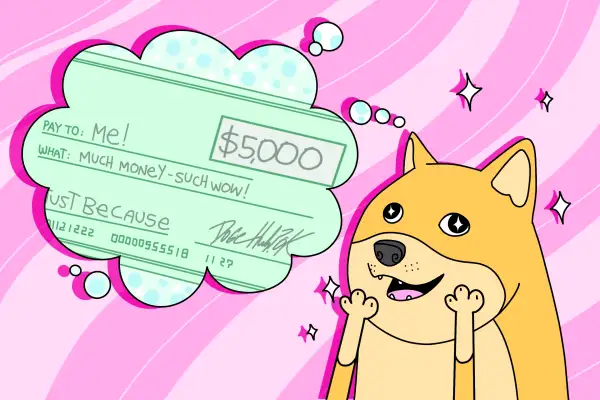'DOGE Dividends': Will You Actually Get a $5,000 Check From Trump?

The Trump administration is considering sending out direct payments to millions of Americans next year.
If implemented, checks of up to $5,000 per household — dubbed “DOGE dividend” payments — would go out after the non-governmental Department of Government Efficiency (DOGE) led by multibillionaire Elon Musk wraps up its work in July 2026.
President Donald Trump recently told reporters aboard Air Force One that he “loves” the idea of the dividend checks. U.S. Treasury Secretary Scott Bessent and Kevin Hassett, the director of the White House’s National Economic Council, have also signaled their support, although no official policy or legislative proposals have been released.
Tasked with eliminating wasteful spending by the federal government, DOGE set a goal of uncovering $2 trillion worth of spending cuts by July 2026, when the agency is set to dissolve. For reference, the U.S. annual spending budget is roughly $6.7 trillion. Two-thirds of that is congressionally mandated spending, largely on federal programs like Social Security, Medicare and Medicaid.
Assuming DOGE meets its goal, 20% of the savings, or $400 billion, would be earmarked for DOGE refunds. The payments would need to be authorized by Congress.
The idea was developed by James Fishback, a DOGE supporter with connections to the Trump administration who posted a viral four-page proposal on Musk’s social media platform, X. It gained the attention of Musk, who then pitched it to Trump.
Here’s what to know about the potential of stimulus-style tax refund checks from DOGE.
Are ‘DOGE dividend’ checks likely?
While the proposal skyrocketed in popularity on the social media site X and appears to have won the approval of the president and his economic advisors, many experts are doubtful the checks will come to fruition as proposed.
The first hurdle is economic. The $5,000 check is based on the premise that DOGE reaches its goal of eliminating $2 trillion in wasteful federal spending. Musk himself has already cast doubt on that. In an interview in January, Musk said $2 trillion was the “best case outcome.”
“You have to have some overage,” he added. “If you try for $2 trillion, you have a good chance at getting $1 [trillion].”
The DOGE website says the cost-cutting initiative saved an estimated $55 billion during the first month of Trump's presidency. To stay on track to meet its target, however, DOGE would need to be saving over $110 billion per month.
“The size of the checks is out of proportion with the size of cuts,” says Ernie Tedeschi, the economics director of the Budget Lab at Yale University.
The second hurdle is political. As with stimulus checks, direct payments to Americans would need to be authorized by Congress.
Already, the proposal is facing opposition from some Republican lawmakers. House Speaker Mike Johnson said he would prefer the money go toward U.S. debt payments. Similarly, Rep. Eric Burlison (R-Mo.) said Friday that the U.S. is not in a position to be sending checks to Americans.
Ultimately, Tedeschi notes, it’s too early to say whether DOGE checks are likely to happen.
Who would be eligible?
According to Fishback, who is also CEO of investment firm Azoria, the refund payment would go to households that pay federal taxes.
Roughly 70% of U.S. Americans have a federal tax liability, meaning that an estimated 80 to 90 million households could be eligible for a check under this stipulation.
Millions of low-income Americans do not owe federal income taxes due to deductions and tax credits. Therefore, they would not qualify for a check if Fishback's qualifications are used.
This is a direct reversal from stimulus checks sent out during the pandemic, as they excluded high-income earners.
Would the checks spur inflation?
Many politicians and economists point to pandemic-era stimulus checks as a major contributor to the recent bout of inflation in the U.S.
The three rounds of stimulus checks, which were dispersed mostly over a three-year period, totaled approximately $815 billion.
Now, with policymakers still struggling to get inflation in check, many economic experts are wondering what injecting $400 billion all at once in the form of $5,000 checks might do to consumer prices.
When asked whether DOGE checks could be inflationary, Hassett of Trump's National Economic Council recently said, “absolutely not,” stating that the DOGE checks would be coming from money that was already set to be spent by the government. Similarly, Treasury Secretary Bessent claimed that “everything that President Trump’s administration is doing will be disinflationary.”
Economists outside the Trump administration aren’t so convinced. Nonpartisan policymakers at the Federal Reserve — the U.S. central banking system that controls interest rates — are already concerned that fresh tariffs from the Trump administration could reignite inflation, according to minutes of the latest Fed meeting (at which they held rates steady).
With tariffs and threats of tariffs already impacting U.S. supply chains, an infusion of $5,000 checks to millions of households may pour gasoline on the fire by spurring consumer demand — or in other words, incentivizing people to go buy stuff at the same time businesses are struggling to get items onto shelves.
As we saw during the pandemic, supply-chain issues plus increased consumer demand are a recipe for inflation.
Certain goods could be at particular risk of price hikes. According to Tedeschi, “consumers are more likely to spend lump-sum checks on large durable goods,” which are major purchases like cars or appliances. These types of goods are among the many items expected to become more expensive due to tariffs and resulting supply-chain issues. Increased demand for those goods would exacerbate the issue.
Another way the dividend checks could spur inflation, Tedeschi says, is if DOGE doesn’t meet its spending-cut goal. For example, if the department decided to send out the full $5,000 but missed the $2 trillion mark, that could cause prices on everyday goods to rise, too.
“This might happen,” Tedeschi says, “if the administration exaggerates how effective DOGE has been.”
More from Money:
The Everyperson's Guide to Managing Money in Trump's America
As 'Layoff Anxiety' Rises, Here's How to Safeguard Your Finances






